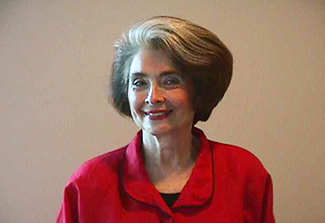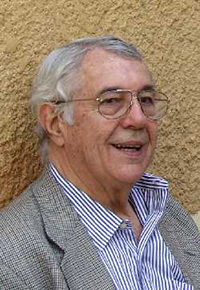Lois Cohen, an abiding NIDCR star, shares memories of Fogarty
September/October 2025 | Volume 24 Number 5
 Photo courtesy of Lois CohenLois Cohen
Photo courtesy of Lois CohenLois Cohen
When Lois Cohen, PhD, thinks of the Fogarty International Center, she pictures Stone House (the Center's building on the NIH campus) in the early 70s shortly after Fogarty was established in 1968.
“I have memories of Margaret Mead living there, and we would come and sit in the living room and listen to her talk.” Other scholars, including microbiologist Albert Sabin, also resided and gave lectures at Stone House and so provided attendees with “the intellectual stimuli to think outside our boxes. I mean, I was a sociologist, but sitting on the floor next to me was an immunologist or a chemist, a virologist, a cultural anthropologist… Fogarty is the place where the disciplines come together and we all sit and learn and have some exchange.”
“That's what Fogarty has meant to me. It’s been an intellectual platform to share insights from global research experiences for the purpose of advancing biomedical and behavioral research,” says Cohen.
Partnerships
Cohen was recruited to the National Institute of Dental Research (an earlier incarnation of the National Institute of Dental and Craniofacial Research or NIDCR) on July 4, 1976, as Special Assistant to the Director David B. Scott. Around this time, dental practice in the U.S. was characteristically a fee-for-service solo practice enterprise (with mostly male practitioners). Dental insurance was rare. The institute’s research focused on: building a larger workforce commensurate with population health needs; expanding community-based prevention programs such as water fluoridation; transforming dentists into oral cavity physicians (so that their checkups included detection of early oral cancers); and examining health delivery system models to more effectively impact population health.
Discussions about national health insurance had begun with President Lyndon Johnson, Cohen says. “We began to look globally. In fact, we had to look outside our own national borders for unique models of health care delivery.” For instance, the Iron Curtain countries (the communist satellite nations of the USSR) had implemented “polyclinics” and these provided oral health care alongside general health care nationwide. Cohen wanted to learn more about them.
Cohen’s proposed study would look at national health systems in highly industrialized countries and how each nation integrated oral health into its system. She worked together with an oral epidemiologist, David E. Barmes, an Australian national. The plan was for Cohen and Barmes to develop a common protocol for collecting information across countries.
“It had never been done before—people had visited other countries and wrote up case study impressions of what was happening, but they never used common measurements that would enable comparisons.”
 Courtesy of NIDCR/NIHDavid Barmes
Courtesy of NIDCR/NIHDavid Barmes
Stone House meetings
Cohen and Barmes began their collaboration by asking researchers with cross-national experiences in the fields of health services research, epidemiology, health economics, health promotion sciences, statistics and other related sciences to advise them on the creation of a common protocol, which they could use to study and compare the different health care systems. “We convened teams of sociologists, health economists and health services researchers from the participating countries at Fogarty’s Stone House,” says Cohen. Team meetings were also held at international conference sites where many of the researchers would be in attendance.
Their first study, an important milestone in Cohen’s career, included sampling sites in 10 countries: U.S., Canada, Australia, Federal Republic of Germany, Japan, New Zealand, Ireland, Norway, German Democratic Republic and Poland. “We had East Germany and West Germany before the unification, so that was fascinating.” West Germany’s system—dating back to Bismarck's time (the mid-1800s)—counted as the oldest system under review.
Japan had a unique dual system, noted Cohen. “Japan used private sector industry-based dental insurance for half of its population. Remember, the Japanese used to work for industry for a lifetime, so they would be covered.” The other half of the population (not working in the private sector) were covered by public sector insurance. “The most controversial program was in New Zealand, where school dental nurses delivered care on a national basis. They weren't dentists, but nurses with two-years of post-secondary school training.”
The International Collaborative Studies of Oral Health Systems (ICS-I) was the largest dental study ever launched, with more than 30,000 public respondents in total, representing three age cohorts.
A leader at NIH
Following the success of this study, Cohen and Barmes conducted a second study (ICS-II) that looked at follow-up data from some of the sampling areas as well as two new Indian Health Service sites among the Navajo and Lakota populations. This second study also included an elderly sample (ages 65 to 74). Both the ICS-I and the ICS-II showed that the average U.S. oral health scores compared favorably with other nations’ scores, yet the gap between the best and worst scores was wider in the U.S. than in any other country.
Meanwhile, Cohen began to oversee international health at NIDCR in addition to her responsibilities evaluating the institute’s programs. In 1998, NIH brought Barmes on as a special expert seated at NIDCR. “When Fogarty brought together all of NIH’s international reps, he would come with me to those meetings and would influence a lot of people around the table. He helped everybody.”
During Harold Slavkin’s tenure as NIDCR’s Director, Barmes and Cohen helped write the institute’s global research agenda for its newly established office of international health. Working with Fogarty and international partners, the Cohen-Barmes team developed an agenda that prioritized a handful of issues, including optimal levels of fluoride, craniofacial anomalies (such as cleft lip and palate), oral manifestations of HIV, and the use of natural substances as oral therapeutics. The agenda, closely aligned with Fogarty’s vision, had “two very important criteria,” says Cohen. “You go where the disease or disorder is most prevalent and you go where scientific expertise is. As one of our investigators liked to say, he would see 50 cases of cleft lip and palate per year in Iowa. In the Philippines, he'd see 500 cases in a week.”
After Barmes passed in 2001, Cohen helped establish the NIH David E. Barmes Global Health Lecture series, which is sponsored by both NIDCR and Fogarty, to honor his lifelong dedication to research aimed at improving health for those in low-income countries.
An interdisciplinary mindset
“Everything was accidental,” says Cohen when asked why she chose sociology for her career.
As a freshman, she attended University of Pennsylvania and then studied abroad for her sophomore year in Israel at the Institute for Youth leaders from Abroad. Her experiences in the then 9-year-old country included living among students and immigrants from both low-income developing countries and highly industrialized nations. Cohen says, “I hadn't had all of this cultural exposure before—being with students from all over the world, seeing these absorption experiments, learning about cultures I didn’t know.” Before she returned for junior year, University of Pennsylvania assigned her a major, choosing sociology since she’d already taken two sections in that discipline. “Sociology really resonated with me following my experiences in Israel. I really liked it.”
Entering the field of oral health was another happy accident for Cohen. After her husband took a job at NIH, she searched for her own position there. A contact at the National Institute of Mental Health, which didn’t have any vacancies, suggested she try the Division of Dental Health. Its newly formed social studies branch immediately hired her.
Over time Cohen grew to love the field. “It was a real opportunity to do interdisciplinary research. There were so many issues that required social science skills rather than dental clinical skills.”
 Fogarty International Center
The Stone House
Fogarty International Center
The Stone House
Global connection
The goal of integrating oral care into primary health care remains elusive in the U.S., still Cohen takes heart from the many significant strides made globally. The United Nations includes oral health in its Political Declaration on Prevention and Control of Noncommunicable Diseases and its various statements on universal health coverage.
Cohen’s current role at NIDCR includes maintaining connections within and among the global oral health community. She shares oral health research highlights with staff at Fogarty, NIDCR, NIH and global organizations. Her work naturally extends beyond NIH. She recently helped launch the first African Association for Dental Education in Casablanca. “The dental schools had never had an organization where they could share information and gain support and build their capacity.”
Fogarty remains essential to maintaining ties with, and learning from, the global community, says Cohen. “So much is happening outside the U.S. that we must keep up with if we're going to stay at the cutting edge.” It’s important that researchers “go where people are in better oral health” to learn. Yet they also need to study dental practices in less-developed countries. “Everything we do in this country costs an arm and a leg. We're so high tech, we've forgotten how to do things in low-cost, simple ways.”
More information
Updated November 19, 2025
To view Adobe PDF files,
download current, free accessible plug-ins from Adobe's website.